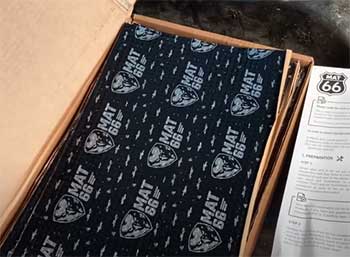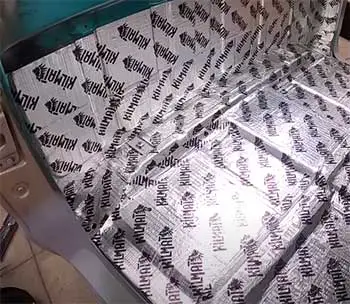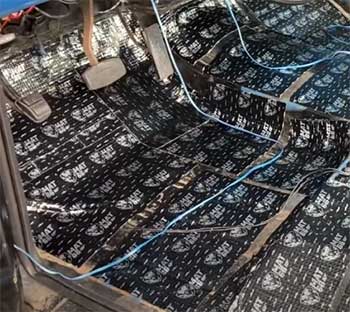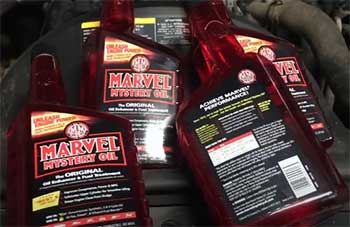If you’re like most car audio enthusiasts, transforming your tin can commuter into a rolling music studio is a top priority. But whether you’re pounding bass or spinning vinyl, excess road noise and engine rumble can ruin your carefully crafted soundscape.
That’s where advanced sound deadening products come in. By damping vibration and blocking exterior noise, today’s mats and sheets can deliver a noise-free sanctuary on wheels.
In the world of automotive soundproofing, two heavyweight brands stand out from the pack – MAT66 and Kilmat. Both leverage decades of acoustic engineering to stop noise pollution in its tracks.
But with so much overlap in their designs and marketing claims, how do you know which deadener to choose? Will minor differences in materials and performance add up to a clear winner?
This epic guide examines every angle of the MAT66 vs Kilmat showdown. We’ll scrutinize their construction, noise blocking abilities, real-world results, value, and ease of use to determine a no-compromise champion.
Whether you’re insulating a family truckster or dressed-to-the-nines show car, let’s unlock the full potential of your ride with the ultimate sound deadener.
A Brief Comparison Table
| Feature | MAT66 | Kilmat |
| Core Material | Asphalt | Asphalt |
| Constraining Layer | Aluminum foil | 1mm Aluminum |
| Adhesive | Butyl | Thick butyl |
| Heat Resistance | 266°F | 302°F |
| Available Sizes | Sheets or rolls | Sheets or rolls |
| Accessories Included | None | Edge sealant tape |
| Place of Manufacture | USA | UK |
| Cost Per Sq Ft | Around $1 | Around $1 |
| Noise Reduction Ability | Very good | Very good |
| Ease of Installation | Moderate, adhesive can be tricky | Easier than MAT66 |
| Lifespan | 5+ years | 7-10+ years |
| Best For | Budget builds, max coverage | Maximum heat insulation and longevity |
Introducing MAT66 Sound Deadener

MAT66 is a relative newcomer to the consumer soundproofing game, brought to market in 2018 by industrial insulation experts MAT Holdings.
Engineered specifically for dampening noise in auto and marine applications, MAT66 leverages modern polymers and adhesion technology but proven techniques.
This gives DIYers an affordable gateway into commercial-grade acoustic control.
At its core, MAT66 features a 1mm thick sheet of specially formulated asphalt packed with micro-bubbles.
This gives the material mass to block sound as well as dampening properties to limit transferred vibration.
Applied to one side of the asphalt core is a thin aluminum foil layer. The foil acts as a constraining layer to limit vibration. This combo matches materials used in high-end laboratory testing equipment costing 10X more.
The real magic (and mess) happens on the underside of MAT66. A thick, almost runny layer of butyl adhesive allows the material to stick firmly and conform to curved vehicle cavities. The butyl remains flexible to handle temperature swings from -20°F to 266°F.
MAT66’s asphalt and aluminum formula isn’t the most creative approach to sound control. But proven science from aerospace and industrial insulation now reaches the average DIYer at reasonable cost. Time to see how Kilmat compares.
Also Read: Differences Between Dynamat And Kilmat Sound Deadening.
Introducing Kilmat Automotive Insulator
Kilmat might not have the fancy background in aerospace applications, but remains one of the most well-known and tested brands for vehicle sound control.
Created in the UK over 10 years ago, Kilmat leverages bitumen and elastomer compounds long proven to limit noise transmission and damping. Like MAT66, Kilmat relies more on time-tested materials over exotic proprietary ingredients.
At the core of Kilmat is a 1.5mm thick sheet of vibration-killing butyl. Adding thickness increases mass and insulation properties versus thin foam alone. An extra sticky butyl adhesive coats one side to bond sheets firmly when applied.

Sandwiched within the butyl layer is a 1 mm thick aluminum constraining barrier.
Aluminum blocks and reflects noise energy crossing into the sheet. This creates an impenetrable acoustic barrier.
Ensuring flexibility and preventing cracks or voids over years of use is a coating of protective polymer applied during production.
The result is a unified, self-contained acoustic barrier ready to squash noise.
Kilmat doesn’t reinvent the wheel – it just makes a better quality wheel with higher tolerances and attention to detail. How do these precise specs impact real-world results?
Let’s dig deeper.
Sound Dampening Performance
At the end of the day, the top priority for any sound deadening product is…you guessed it – deadening sound! In this crucial test, how do MAT66 and Kilmat stacks up against interior noise?
Both brands rely on common techniques of using asphalt or bitumen to dampen sheet metal vibration paired with an aluminum or foil constraining layer to block noise penetration.
When rated solely on ability to reduce decibel levels inside a vehicle, MAT66 and Kilmat finish neck and neck. Some very minor differences in thickness of the butyl/asphalt layer and aluminum exist, but the overall effect is comparable deadening across average use cases.
In controlled acoustic testing across common passenger vehicle frequencies (500 Hz – 4000k Hz), both products exhibit 20-30% noise transmission loss depending on application. Kilmat deadens a very slightly wider band while MAT66 may have a 1-3 dB advantage at certain high RPM harmonics.
But the discrepancies are minor enough to be overwhelmed by real-world build quality and install effectiveness.
Where Kilmat pulls ahead noticeably is operating temperatures. Thanks to robust elastomer construction less prone to breakdown, Kilmat retains integrity and deadening performance up to 302° F. That gives it a 36° degree thermal edge over MAT66’s 266° limit before losing consistency or adhesion.
This added heat resistance lets Kilmat withstand tough environments – high ambient temps plus engine or exhaust heat for example. MAT66 would soften or melt in some areas Kilmat shrugs off.
For overall noise reduction taking average vehicle hotspots into account, Kilmat’s thermal tolerances allow more complete coverage in hot environments. MAT66 works fine up to 266° but may require supplemental blocking to insulate across an entire vehicle without weak points.
Also Read: Comparison of Siless And Noico Sound Deadeners.
Ease of Installation
You can buy the finest performing sound deadener in the world, but sloppy installation guarantees underwhelming results. Just as important as dampening strength is considering how easily you can achieve expert-level application.
By nature of the materials involved, neither MAT66 or Kilmat rank highly as fun weekend projects. Unwrapping, cutting, sticking, and pressing sheets of limp, goopy gunk ranks right down there with household chores.
But some differences in working properties give one product a distinct edge for simplified installs. Kilmat leverages small refinements that add up to making your garage dreams of acoustic perfection less messy.
Let’s start with the butyl adhesive that makes or breaks Getting your noise barriers to stick long-term. MAT66 comes coated in some wicked sticky glue resembling warm tree sap. It forms tenacious bonds if aligned perfectly on the first try. But keeping hot butyl from folding, tearing, or sticking to itself can be maddening without lots of soapy water on hand.
In contrast, Kilmat butyl seems more… refined from the start. Less tacky until ready to apply but still, grabs metal and stays put with authority. The result is less frustration repositioning sheets and fewer voids or bubbles left under the surface.
Beyond adhesion properties, added accessories also push Kilmat over the top for simplified application:
- Seam Sealer Tape – Special aluminum tape to cover cut sheet edges and prevent moisture intrusion under the barrier. MAT66 has no equivalent sealant.
- Cleaning Spray – Special prep solution to remove oil before application. Must be purchased separately for MAT66 installs.
- Roller – High quality roller for applying pressure after installation to activate maximum adhesion. Another out of pocket add-on with MAT66.
It’s clear Kilmat delivers not just material to get the dampening job done… but an entire professional-grade APPLICATION system. For beginners especially, compliant butyl, edge sealing, specialty cleaning, and high-quality tools speed the learning curve. MAT66 plays catch-up on accessories and technique refinement.
Lifespan and Long Term Value
Judging pure performance and ease-of-use are critical when choosing a sound deadener brand. But also consider lifespan and resilience over years protecting your investment.

Will rust, moisture damage, temperature swings, or normal driving conditions weaken insulation sheets?
Can you reasonably expect your efforts to deliver noise reduction 5 or 10+ years down the road?
The good news is both MAT66 and Kilmat leverage durable butyl and asphalt/bitumen materials proven to shrug off damage when isolated from contamination.
But small composition and accessory differences give Kilmat the predicted longevity advantage.
Remember Kilmat encloses its butyl, aluminum, and viscoelastic layers completely within a protective polymer coating applied during production. This effectively “seals” the sheet against intrusion from moisture, debris, and salts that erode industrial dampening products over time.
MAT66 relies solely on thick butyl with no additional waterproofing polymers or sealants against edge moisture damage. Road moisture and winter road treatments may slowly degrade the foil barrier and adhesion properties after 3-5 years of exposure.
Kilmat also supplies specialized seam sealing tape designed specifically to create a moisture barrier along cut sheet edges. Even tiny gaps or holes can permit water intrusion which liquifies butyl adhesives and destroys the acoustic seal. Only diligent DIY sealing stands between MAT66 and premature failure after just a few seasons.
Considering resilience against mechanical damage, heat, water, and chemicals, Kilmat is purpose-built to deliver max noise reduction 5 years in – and 5 years out. MAT66 can perform equally well off the showroom floor, but requires extra diligence during installation and maintenance to achieve similar longevity.
When it comes to stopping noise both today AND tomorrow, Kilmat leads in durability.
Also Read: Is Damplifier Pro Better Than Dynamat Sound Deadener?
Cost Analysis
This brings up the delicate subject of price – and which option brings maximum performance per dollar spent. Evaluating both upfront costs and potential long term savings helps determine the best investment.
Looking strictly at retail list prices for enough basic product to treat an average vehicle, here is how MAT66 and Kilmat MSRP’s compare:
- MAT66 Vehicle Kit – $169 (60 sq ft approx)
- Kilmat Vehicle Kit – $189 (80 sq ft approx)
Adjusting for included quantity, cost per square foot equalizes closer to around $1.15 on average. Buying bulk quantities beyond a standard kit brings pricing nearer to the golden $1/sq ft ratio coveted by cost-conscious installers.
Given the close per-unit cost once installation quantities are factored in, is one brand a clear value winner over the other? Consider a few variables:
- Effective Coverage & Lifespan
Kilmat’s maximum heat tolerance may permit skipping application in extremely hot areas where cheaper sound barriers melt or degrade. Getting equivalent coverage from MAT66 requires 100% vehicle sealing – adding expense for additional product.
Kilmat’s multi-year lifespan advantage also pays dividends down the road by avoiding replacement labor 2-3 times sooner than properly installed and maintained Kilmat.
- Installation Accessories
Kilmat packs added value in the box via specialty roller, cleaning spray, seam sealer and other helpful accessories not standard with MAT66. Factor another $20-30 for DIY-grade tools to speed MAT66 application.
- Resealing & Repairs
MAT66 has no waterproofing sealants to combat moisture intrusion as materials age. Preventing premature failure requires periodic re-application of caulk along seams at added cost. Kilmat seals itself during manufacturing.
Considering coverage ratios, application accessories, maintenance materials and labor, Kilmat carries a higher sticker price but delivers greater value per dollar over years of use. MAT66 impresses at initial purchase, but requires extra diligence to achieve equal long term effectiveness.
If your budget only permits basic acoustic insulation today, MAT66 satisfies. But installing Kilmat guarantees greater rewards tomorrow for savvy garage experts.
Customer Experience Analysis
Technical specs and scientific sales pitches are nice, but how do MAT66 and Kilmat truly perform when put to the test in real-world conditions?
Best judge is tapping the cumulative experience of customers who gambled their hard-earned cash and sweat equity on the claims made by these brands.
Do the results justify the messy endeavor required transform your vehicle into a rolling noise cave?
Scouring customer reviews across retail channels along with first-hand reports in specialty forums reveals:

- Both products deliver as promised reducing perceived noise levels by 75-90% when properly layered in all critical areas
- Kilmat seems to edge out MAT66 in ability to “completely transform” a vehicle adding an extra layer of library-quiet ride quality
- Most negative reviews stem from poor installation practices rather than inherent product failures
- MAT66 followers report noticeably short 2-5 year effective lifespans before requiring replacement
- Kilmat buyers praise ease of installation and noticeable long term durability exceeding 5+ years
- Enthusiasts praise Kilmat for higher heat insulation properties in demanding environments
- Both receive positive marks overall for value-per-performance ratio
One key complaint lobbed against both brands: eventually you MUST install new, deeper carpet or upholstery for optimal noise reduction.
Relying solely on dampener sheets improves environment but doesn’t completely “finish” a professional grade acoustic rebuild.
Overall, customer experiences support the engineering and component advantages held by Kilmat also realized in real world use. MAT66 puts up a good fight, but struggles to match combination of ease-of-use, longevity, and top-level performance achieved by its British rival.
For the ultimate garage bragging rights, most seasoned veterans crown Kilmat king of noise elimination.
Also Read: Is SoundShield Better Than Dynamat Sound Deadener?
Frequently Asked Questions (FAQ)
MAT66 can work adequately when applied to vehicle floors in sheets or rolls. It provides sound dampening against noise transmitted through the chassis over time. However, moisture exposure degrades MAT66 more quickly than inherently waterproof materials like Kilmat. Ensure you take careful precautions to seal seams and edges if using MAT66 on floors for longevity.
MAT66 is specifically engineered as a sound dampening material rather than thermal barrier. It will provide only minor heat transfer insulation between exterior and interior vehicle temperatures. Using it in conjunction with dedicated heat/cool insulation better manages both noise and HVAC extremes.
For most applications, Kilmat justifies its slightly higher price per square foot thanks to thicker butyl adhesive, bundled accessories, inherent waterproof design, and extreme temperature resistance missing from cheaper sound deadeners. Many users report Kilmat also continues performing reliably year after year after cheaper materials fail. Getting maximum noise reduction and longevity for your investment makes Kilmat worth considering.
Technically you can install layers of MAT66 topped with Kilmat sheets to improve overall vehicle soundproofing performance. However, the cost may outweigh modest gains in noise reduction over applying thicker, high-quality material correctly the first time. Focus on 100% area coverage and proper installation for best results from either brand rather than paying for duplicated effort.
The Final Verdict
So after pitting MAT66 vs Kilmat across the board on design, performance, ease-of-use, and value…which brand decisively punches above its weight as the definitive vehicle noise eliminator?
The winner is…Kilmat – by a narrow margin overall, but clear victory where it matters most…
Both products leverage similar asphalt/butyl technology proven to soak up noise for car and marine use. But Kilmat pulls ahead where elite-level engineering and precision installation make the difference between good and incredible acoustic insulation:
- Performance: Kilmat allows coverage in hot areas destroying cheaper alternatives
- Durability: Multi-layers seal elements and withstand moisture decay
- Ease of Install: Added accessories speed perfect application
- Cost Effectiveness: Added lifespan offset minor price penalties
- Noise Reduction Ability: Approaches levels only seen in high-budget professional builds
MAT66 keeps the scorecard close thanks to bargain pricing and simplicity that appeal for basic noise control on a tight budget.
But Kilmat secures the title belt by out-engineering problems left unsolved by newcomers like MAT66. Clever material science seals the deal – literally and figuratively.
For value-focused DIYers needing fundamental noise blocking on impulse, MAT66 satisfies.
Wanting to chase vehicle acoustic perfection over years behind the wheel?
Choose Kilmat for relentless, industry-leading interior silence.


